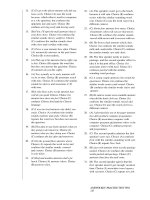READING STRATEGIES FOR TOEIC TEST ppsx
Bạn đang xem bản rút gọn của tài liệu. Xem và tải ngay bản đầy đủ của tài liệu tại đây (100.11 KB, 2 trang )
READING STRATEGIES
1. OVERVIEW QUESTIONS
The most common overview question asks about the purpose or main topic of the
passage. Other overview questions ask about the writer of the passage or the
reader of the passage.
What does this article/the memo mainly discuss?
What is this form?
What is the purpose of this letter/announcement/notice…?
Why was this notice/letter written?
In what business is the writer of the passage?
What kind of business is Mr. ________ probably in?
Who issued/wrote this notice?
What is the author’s opinion of ______?
Who were these instructions written for?
Who would be most interested in the information in this announcement?
For whom is this advertisement/notice intended?
- Don’t answer the initial overview questions until you have
answered the other questions
- Usually focus on the title and the first sentence(s) of each
paragraph for the topic and main idea; also focus on the last
sentence for the conclusion and a possible restatement of the
topic and main idea.
- Skim (read very quickly) the rest of the passage for the key
words that will confirm the topic and main idea.
- Read the answer choices and eliminate the distractors which
may have one of these characteristics:
a. too general
b. too specific (detailed)
c. incorrect
d. irrelevant (not mentioned)
II. DETAIL QUESTIONS
1. Information/Factual Questions often begin with the phrases
“According to the passage/the author, wh- questions ”
2. Negative Questions contain the words NOT, EXCEPT, or LEAST
- Focus on one or two key words in the question
- Scan the passage looking for the key words or related words
(synonyms, word family)
- Carefully read the sentence in which the key words occur. (You
may have to read the sentence preceding or following that
sentence as well.)
- Choose the correct answer
III. INFERENCE QUESTIONS
Inference Questions usually include such words as “infer, imply, suggest, guess,
probably, or likely” or such phrases as “Why … mention?” “What …. to do next?”
“Which of these … is probably true?” and “ What … probably do?”
Answer choices to inference questions require students to
1. understand what the question is asking and know where to find the
answer in the passage
2. relate the information in the answer choice to a synonym or paraphrase of
information in the passage; and
3. determine what is true and not true in the answer choices
• Note : Answer choices that contain such words as
always, never, all, and only are usually NOT
correct.









